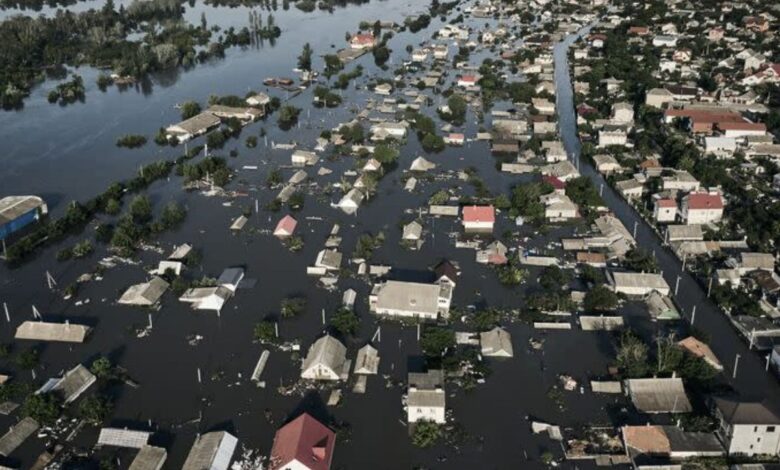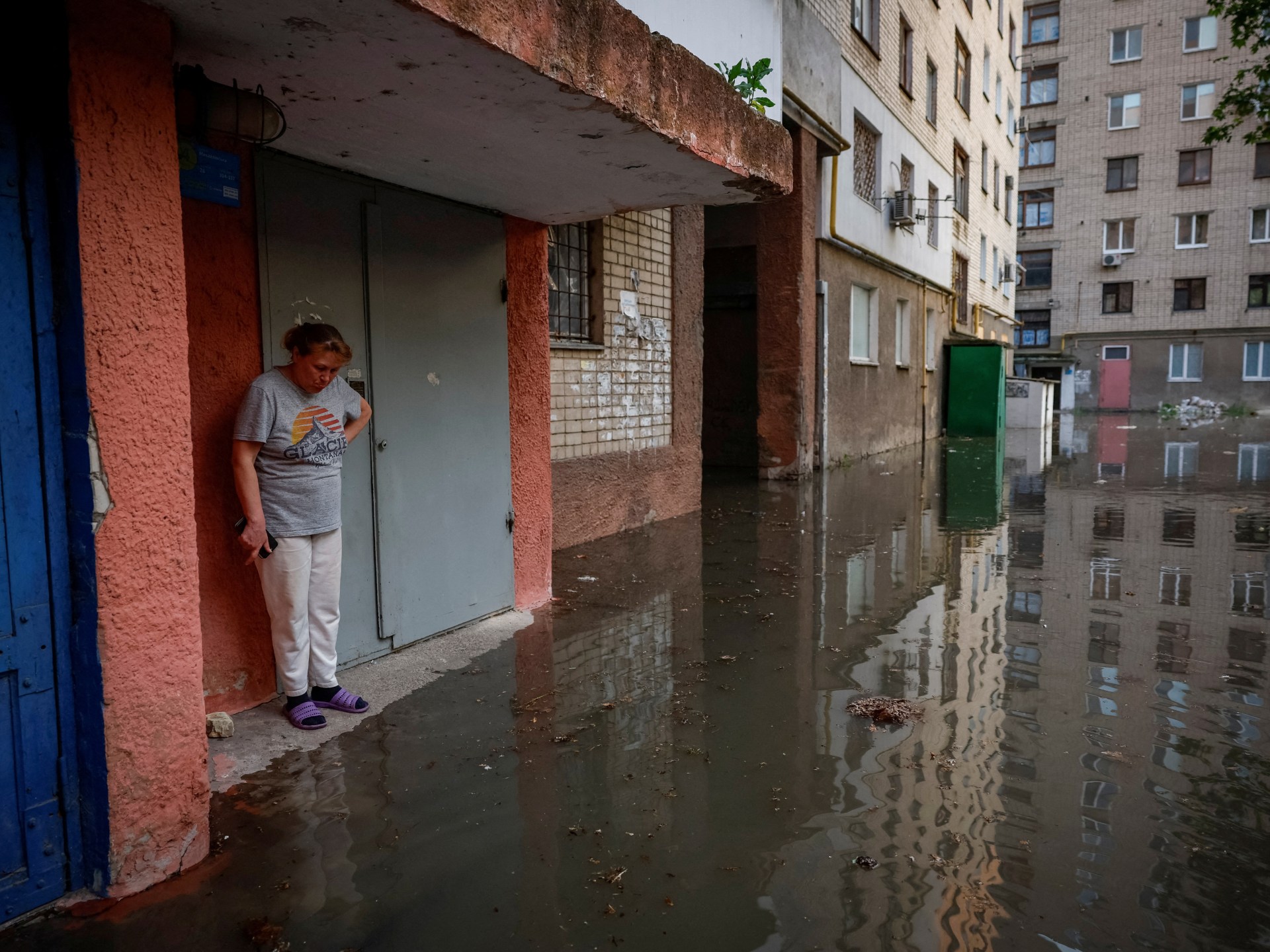The Collapse Of The Kakhovka Dam In Ukraine May Effect 2 Million Lives, Adding A New Political Irritation To The Russia-Ukraine Conflict.
Ukraine's President Volodymyr Zelensky has stated that the ecological calamity caused by the collapse of the Nova Kakhovka dam has become a global issue due to the flow of highly polluted water into the Black Sea.

The aftermath of a dam burst in southern Ukraine is causing havoc on lives, livelihoods, and the environment amid the conflict.
A major dam in southern Ukraine recently collapsed, flooding communities, destroying crops, and jeopardising drinking water supplies. At the same time, both sides in the conflict hurried to evacuate civilians and blamed one other.
Ukraine accused Russian soldiers of blowing up the Kakhovka dam and hydroelectric power station on the Dnieper River in a region held by Moscow for more than a year. Russian officials accused the Ukrainian bombing the disputed territory, which is divided by the river. The contradictory allegations could not be harmonised.

Russian and Ukrainian officials used language like “ecological disaster” and “terrorist act” to describe the torrent of water flowing over the collapsed dam. They began to empty an upstream reservoir that is one of the world’s largest.
As houses, streets, and businesses flooded, officials raised worry about drinking water supplies, and rescue services evacuated hundreds of people from Ukrainian and Russian-controlled districts.
Both Russian and Ukrainian officials dispatched trains and buses to transport inhabitants to safety. Around 25,000 people in Russian-controlled territories and 17,000 in Ukrainian-controlled regions should be evacuated, Ukraine’s deputy top prosecutor Viktoriia Lytvynova stated on Ukrainian television. The death toll from the flooding has risen to six, with the Moscow-backed government of Nova Kakhovka reporting five deaths and 41 hospitalisations.
Further, Ukraine’s President Volodymyr Zelensky has stated that the ecological calamity caused by the collapse of the Nova Kakhovka dam has become a global issue due to the flow of highly polluted water into the Black Sea. According to Zelensky, the flood waters flowing through the lower Dnipro River valley carried sewage, oil, chemicals, and probably anthrax from animal burial places.
There are at least two anthrax burial sites in the briefly held territory. They don’t know what’s happening to those places yet, Zelenskiy stated in an online conversation with environmental activists. Aside from the 100,000 people impacted downstream, 50,000 hectares of forest have been inundated, and 20,000 animals and 10,000 birds are “under threat of imminent death,” according to Zelensky. He went on to say that by the spread of contamination, 2 million people are at risk.
Farming in Ukraine Is a ‘Much Bigger’ Problem Now.
The Ukrainian agriculture ministry stated earlier this week that the dam’s demolition would not only flood tens of thousands of hectares of agri-land in the country’s south but would also change at least 500,000 hectares of unirrigated land into “deserts.”
It stated that the tragedy would cut off water supplies to 31 irrigation systems in the Ukrainian regions of Dnipro, Kherson, and Zaporizhzhia, which irrigated 584,000 hectares. He described irrigation as a “major long-term issue for agriculture in the region.” “It is impossible to grow vegetables without a source of water supply.” According to the government, the government will farm Grain and oilseeds using a large model with poor yields. Ukraine is a major producer and exporter of grains and oilseeds global.
The political angle on the destruction of the dam.
The dam burst, which both sides had long expected, provided a dramatic new dimension to Russia’s 16-month-old battle. Ukrainian forces were generally observed advancing in more than 1,000 kilometres (621 miles) of the front line in the east and south.
It was unclear why either side would demolish the dam; its collapse may have been caused by slow deterioration. Land under Russian control, and Ukrainian management, was under threat.
Russian Defence Minister Sergei Shoigu accused Ukraine of destroying the dam to deter Russian strikes in the Kherson area following a failed Ukrainian counteroffensive. He said Ukraine had lost 3,715 troops and 52 tanks since Sunday, and 71 Russian servicemen dead and 210 injured, in a rare acknowledgement of Russia’s casualties. Ukraine adhered to its usual practice of refraining from remarking on its casualties.

Zelenskyy’s administration was aware last year that Russia had mined the dam; thus, “there may come a moment when an explosion occurs.” Other Ukrainian authorities said Russia blew up the dam to stymie Kyiv’s counteroffensive, even though crossing the wide Dnieper would be exceedingly tricky. Analysts believe that other front-line industries are more potential targets.
The purported Russian dam demolition, according to Nigel Gould-Davies, a senior fellow for Russia and Eurasia working at International Institute for Strategic Studies, was “a profoundly defensive measure”, demonstrating “Russia’s lack of confidence in its longer-term prospects” in the conflict.
Experts earlier stated that the dam was in disrepair, possibly contributing to the break. In an email, David Helms, a retired American scientist monitoring the reservoir, said it was unclear if the damage was intentional or the result of occupying Russian soldiers’ negligence.
However, Helms pointed out that Russia has a history of bombing dams.
Wheat prices rose 3% after the fall, highlighting the global ramifications. It’s unclear if the surge was caused by a genuine fear of flooding ruining crops. Ukraine and Russia are major global providers of wheat, sunflower oil, barley, and other agricultural products in Africa, the Middle East, and Asia.
For months, several authorities, scientists, and citizens have been concerned about water spilling through – and over – the Kakhovka dam. Water levels soared beyond average following heavy rains and snowmelt last month, drowning adjacent settlements. Water washed over broken sluice gates, according to satellite pictures.

The act was also condemned internationally, particularly by German Chancellor Olaf Scholz and NATO Secretary-General Jens Stoltenberg, who stated the “outrageous act, demonstrates once again the brutality of Russia’s war in Ukraine.”
Proofread & Published By Naveenika Chauhan





